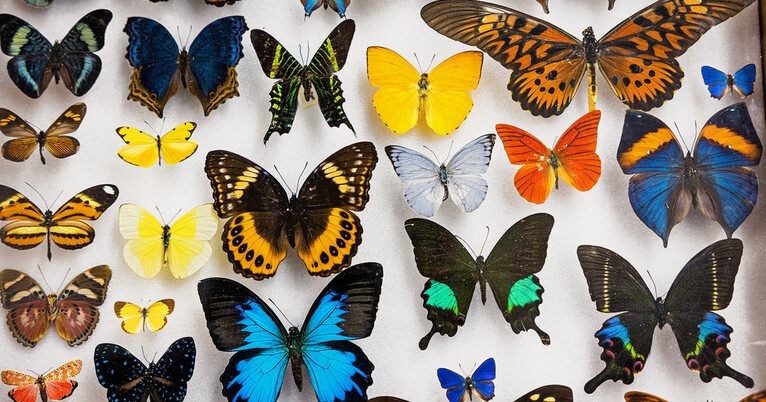For art students, Peabody specimens offer lessons in color and truth
Larry Gall pulls out a glass-covered case containing a dozen blue morpho butterflies. He rocks the box back and forth to illustrate how the butterflies shimmer. The Yale students who’ve gathered around him all pull out their phones to snap photos.
In nature, he tells the group, color can come from pigments that absorb light as well as from structures that reflect certain wavelengths of light. In this case, says Gall, the entomology collections manager at the Peabody Museum, the stunning, shimmering blue of the blue morphos comes primarily from tiny structures on the scales of the wing, rather than pigment.
Whether it’s due to pigment or structure, perception of color stems from the manipulation of visible light. But some animals, like many insects, can also see ultraviolet light, something human eyes can’t perceive. To the human eye, a set of yellow Sulphur butterflies in a display case can look pretty similar. But when Gall showed the students what the same specimens look like under ultraviolet light, as they would appear to some animals, they suddenly look quite different, with patterns emerging where they didn’t appear to exist before.
The comparison offers a vivid illustration of the role color can play in nature and the wide visual world we humans can’t access.
The students are undergraduates in the Yale School of Art’s “Color Practice” course. During the semester, the class also visited the University Art Gallery and the Robert B. Haas Family Arts Library, but today they’re learning all about color in nature through the Peabody Museum’s many specimens and the expertise of its collections managers. In addition to viewing insects in the Environmental Science Center, the students also observe minerals in the Kline Geology Laboratory and the Peabody’s iconic bird collection during the class session.
The experience emphasizes a key lesson of the course — that color is not concrete. Its environment and our perception of it can dramatically change its character. And for many students, seeing the role color plays in the natural world jumpstarts their creativity.
“It’s definitely influenced my view of the world,” says Ana Greenberg ’22, adding that the class has seeped into many aspects of her life, even small things like what she wears, how she decorates her apartment, and the colors she chooses when knitting. It’s had larger impacts too, like reshaping how she views nature.
Much of what the students learn builds on the work of Josef Albers, whose “Interaction of Color,” a guidebook on teaching and studying color, is used in the class, said Anoka Faruqee, a professor at the School of Art who leads the course.
“The thing that Albers championed, which I think many artists can relate to, is the fluidity of color and the fact that color is very relative and it changes in context,” says Faruqee. “And it brings up ideas around truth and whether truth exists in contingent experience or whether truth exists in isolated fact. In other words, what we know versus what we perceive or experience.”
Deciphering the mysteries of color
Inside Room 105 in the Kline Geology Laboratory, Stefan Nicolescu, the Peabody collections manager for mineralogy and meteoritics, holds up a tuft of blue crystals of a mineral known as hemimorphite. As it turns out, the object’s eye-catching color, he tells the students, was a complete fraud that duped mineral collectors around the world in 2020.
It’s a captivating tale that involves drug cartels, scientific sleuthing, and a chemist who ran a spectral analysis of the crystal and, having worked for a pigment manufacturer, immediately recognized the culprit — denim dye.

Typically, the causes of color illusions are less nefarious. Nicolescu illustrates to the students how color can change when seen in a different light. He shines a blue light laser pointer on the stones of rings to make them fluoresce; he directs the beam of a flashlight through the back of a thinned slab of rock to reveal the translucent garnets embedded within.
Then there’s the idea of structural color. Nicolescu tells the students how the greens, pinks, and blues of mother of pearl, an iridescent material that coats the inside of some mollusk shells, actually come from its structure. When ground up, he says, mother of pearl is simply white.
For Harper Lowrey ’23, the notion that color is sometimes not inherent to an object is mind-blowing. “In class, we’ve been thinking a lot about what color means and how we interact with it,” she says. “So, it’s really cool to engage the natural side and learn about how color is constructed.”
Lowrey, who is considering majoring in molecular, cellular, and developmental biology, says this art class that utilizes the Peabody collections reflects her blended interests. “I’ve always been the person with every pocket of my backpack filled with rocks and leaves,” she says. “Thinking about what art is in relation to the natural world has been really interesting.”
In classes like this one, David Heiser urges students to think about the Peabody museum’s collections as if it were a library. Just like books, these specimens and objects are resources for them to tap into in whatever way makes sense.
“Yale as an institution has these remarkable collections across all of these different areas,” says Heiser, the director of student programs at the Peabody. “A lot of these collections are more like a reference collection at a library. You can’t check it out, but you can definitely be in its presence and learn from it and make use of it and take pictures of it and continue to learn from it and draw or paint it.”
He has worked with faculty members across the university. In some courses, such as those that examine mammalogy or herpetology, the connections to the Peabody’s resources are obvious. But, for Heiser, it’s the courses with less intuitive connections that become truly memorable. For instance, he recently worked with an instructor at the School of Architecture on a course about animal dwellings, using bird nests, cocoons, termite mounds, and wasp nests as examples of built structures in the natural world. He’s also teamed up with an art history instructor on a course about art in the Anthropocene, or the period of time during which humans have become the dominant influence on the planet.
The benefits of these collaborations work both ways, Heiser says. He recalls working with former School of Art faculty member Anna Betbeze on her own color course. When he mentioned all of the iridescent specimens found in the Peabody’s collections, Betbeze asked to display them all together, side-by-side. The result was one of the Peabody’s first study gallery displays, which was opened to the public and used for student instruction.
“Getting a chance to introduce students to that concept in a scientific way in front of iridescent specimens themselves is, to me, the perfect way to merge art and science at the university and to bring the collections to life for a group of students,” says Heiser.
Understanding differences in perception
Later, the School of Art students return to the Environmental Science Center, where the Peabody’s bird collection is the last stop.
Kristof Zyskowski, the collections manager for ornithology and mammalogy, holds up a bird made famous by the series “Planet Earth.” It’s a type of bird-of-paradise native to Papua New Guinea; when it spreads its feathers to engage in a mating dance, it looks like a dark black oval with a strip of reflective blue.
Yale researchers discovered that the black visible on the bird isn’t just black. It’s ultra-black — a color created by both pigment and structural color. As Zyskowski explains, the color was later found in other bird species and in beetles. And in each case, the ultra-black was found to be next to some visual ornament — like the blue strip found on the bird-of-paradise — as if the role of this special color is to emphasize important features.
Zyskowski introduces birds from Brazil, Australia, South America, Africa, and Thailand. He also shows the group some species found closer to home. He points out two albino birds collected in East Haven and Danbury, Connecticut, and challenges the group to name the species. Two students quickly identified a blue jay and an American robin. Reflecting on the importance of color in nature, one student asks how these birds would have fared out in the wild. “They would’ve had a hard time,” says Zyskowski. “These types of birds are often picked on by others.”

Zyskowski then dives deeper into a concept first introduced during the entomology portion — the idea that not all species perceive color the same way. He shows the students a bird with an ultraviolet-orange patch of feathers, a color that includes the orange humans can see and an ultraviolet color that we can’t. It’s a blend that is, for birds, as different from orange as purple is from red or blue.
These different perceptions of color result from how different wavelengths of light stimulate light-sensitive cone cells in the retina, says Rick Prum, the William Robertson Coe Professor of Ecology and Evolutionary Biology and the Peabody Museum’s curator-in-charge of birds.
“Most humans have three types of color cones that are sensitive to red, green, and blue light,” he says. “But birds have four types of color cones: red, green, blue, and ultraviolet (or violet) cones. So, birds can see well into the ultraviolet range that is invisible to us.”
‘A great place to learn about the world’
The class heads outside to discuss what they’ve seen. “I feel so limited now,” says Faruqee, a painter. “I only get to use pigments!”
Jake Jorgl ’23, an art major, says he is thinking about how to recreate the effect of structural color by thinly layering oil paint so that each translucent layer builds additive color, not unlike the mother of pearl in the mineral collection. “It’s not the same thing as structural color,” he says, “but there are some similar aspects to it and it makes it different than mixing pigment and putting that onto a canvas.”
Byron Kim, a senior art critic at the School of Art who has taught a similar course to graduate students, says you can define structural color for him but it’s when he sees it in minerals or bird feathers that it all makes sense. “The combination of having it explained and seeing it — there’s no substitute for that.”
It’s a reaction Prum has seen before. “The key indicator of whether or not these types of classes work is whether the students leave with their minds completely blown,” he said. “Usually, we have a very high success rate!”
Kim remembers visiting the Peabody as a child. The mood of the museum, he says, has remained with him ever since. “It was really good fuel for my imagination,” said Kim, “somewhat haunting but also kind of adventure-making in my mind.”
He says that he likes to teach his course in a way that relates to his students’ lives not just their studios or their paintings, showing color in the world rather than just in art. “The Peabody’s such a great place to learn about the world.”













